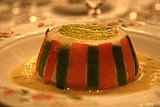Home |
Restaurants by City
|
Food Photography |
Archive | Philosophy |
![]()
Right now we are eating in Seattle, Washington.
|
Tuesday
2006
Permalink
|
A Week at the Culinary Institute of America (continued) - The Restaurants, Hyde Park, NY, tasted on December 19-22, 2005 We've spent several posts describing every detail of the week spent at C.I.A. Bootcamp. One of the perks of bootcamp is eating at the on-campus restaurants each night for dinner. These are typically hard-to-get reservations and the students at bootcamp are escorted to the front of the line. Given that creating people who can earn a living in professional food service environments is the goal of the school, the restaurants should be examples of some of the best cooking that the school can produce. While the students are serving food every day from kitchens throughout the school, these are the only ones serving paying customers from outside the surrounding area. On the other hand, the restaurants are staffed primarily by students who rotate through (working as waiters too) every few weeks. So consistency is bound to be a challenge. There are several restaurants at the Hyde Park campus that are open to the public. They are: St. Andrew's Cafe, Ristorante Caterina De Medici, Escoffier Restaurant, American Bounty Restaurant, and the Apple Pie Bakery and Cafe. Our dinners were planned each night for the first three restaurants. The Apple Pie Baker and Cafe was more of a coffee shop that we would go to during the day. We never ate at American Bounty. The first night we ate at St. Andrew's Cafe. It was essentially random. Even some of the full-time students warned us before we went that St. Andrew's had no real focus and was the only restaurant on campus that lost money. I don't know if the financials are accurate, but the lack of focus was definitely an issue. And while lack of some sort of thematic coherence was definitely present, that's not really what bothered me. To a certain extent I don't mind if the dishes come from all over as long as they taste good. But essentially the lack of focus that was the most glaring was in terms of quality. I know this sounds cruel but St. Andrew's was kind of like trying to be upscale Appleby's but in the end not even really as good. Because it tried to set your expectations higher, but failed. Ristorante Caterina de Medici where we ate on the second night was not much better. In truth, the high points at Medici were much higher than the high points at St. Andrew's. But the lows seemed somehow lower as well. Some of the food had decent flavor, but overall it came in such enormous portions that my appetite wilted as I saw these heaping piles of food arrive. There gets to be a point when the amount of food is so large that by definition by the last bite will be subpar because by the time you get to the it (if you can make it that far) the window in which the dish was at its peak has long expired. I know there are new students rotating in and out of the kitchens in these restaurants all the time. But these kids are not designing the dishes. I also know that the school is dedicating to producing students who are professionals at making food that is cooked in the bulk of food service establishments in the United States. And in truth, the food at both Medici and St. Andrew's is, well... typical of what you can find across the country. But shouldn't a school have some responsibility to set the agenda for what constitutes quality food in this country? I bet if I asked the folks at the C.I.A. they would readily agree. In that case I would say that the dishes we were served these first two nights were not designed with simplicity in mind. From my perspective, the golden rule when it comes to making good food is to simplify. Every variable represents an opportunity to mess the dish up. The fewer the variables, the smaller the odds that the food won't be good. I understand that students are learning the ropes all the time and bound to make mistakes. But if the dishes they are meant to serve had more focus, I bet they would master them more easily. At one point in the week one of the staff members asked me what I thought of the restaurants. I told them what I thought. Their first reaction was to remind me that the service was being done by students new at the job. I know for a lot of people, impeccable service is just as important as the food. And I understand that perspective even though it's not mine. But the truth is that the service was pretty good and got progressively better throughout the week (culminating in the full on fancy Russian service at Escoffier). And even when there were hiccups, I don't know any way to say this that doesn't sound condescending, but in truth it was kind of adorable. All the students were trying so hard, and for some it was clearly a challenge to figure out how to wait tables. Even though I've never waited tables myself, it's obviously a super hard job to do perfectly. I know they were all doing way better than I could. Our last night was reserved for Escoffier the fancy French restaurant on campus. This was clearly an upgrade from the other restaurants in terms of the quality of the food and the experience. And in some ways it's a shame. I swear that I don't automatically upgrade the impression I've had of a restaurant just because there is Foie Gras on the menu. That said, it's almost as if the restaurants felt that if you're going to serve French food and have a higher price you need to have higher quality to justify it and do the experience justice. Personally, I'd like the same attention to detail and quality bar applied to my pizza or my Beef Wellington. And even though the quality was much higher, Escoffier was a mixed experience for me. On the one hand some of the dishes were quite tasty. On the other hand, a heavier traditional French menu is not necessarily in my sweet spot for something I'm dying to have. And even if it was, the meal was soulless somehow. It's like they were doing their best impression of making Michelin starred food from France. Kind of like some of the restaurants in Vegas. This is what Simon means when he tells an aspiring idol with a beautiful voice that they belong on a cruise ship. Escoffier is definitely a good restaurant, and if I lived in Hyde Park, NY (2-3 hours outside Manhattan) I'd probably be eating there once a month. But again, I felt it came up short in terms of giving the students aspirations that were beyond what qualifies as high quality for the mass market. Then again, when you look at who our culture elevates to status as celebrity chef, maybe it's no wonder that this is what they're aspiring to achieve. Have any of you eaten at one of the myriad expressions of Wolfgang Puck's culinary "vision"? I love how they give the impression on the NBC show Las Vegas that Wolfgang Puck is actually cooking at his restaurant in the Montecito (the fake casino that the show is about). Puck can't even convince me he's actually fake cooking at his fake restaurant never mind really cooking at his real restaurants. We reward him with celebrity and culinary expert status. What he really deserves are accolades for his business acumen. I also don't doubt the guy can cook up a storm. But if you're looking for good food, I wouldn't go to any restaurant with his name on it.
|
|||
Our Sponsors
Free Car Listings Hot Tubs Stools Saunas Bar Stools - Calendar and Event Schedules - Food Events and Calendars - Wine Events and Calendars - Digital Photography Resources - Software for Advertisers - Jewish Gifts and Judaica - Howard Stern Podcast - ponytailed blogger Jonathan Schwartz

Browse tastingmenu
Home |
Restaurants by City X |
Food Photography |
Archive | Philosophy |
![]()
Free eBooks: All About Apples
| Autumn Omakase
More:
Discussion |
Cool Food T-Shirts |
Ingredients
| Markets |
Recipes
Search |
Blog FAQ |
Other
Blogs
Best of tastingmenu
|
City View
Entry: July 6, 2006 |
Blue Plate
Entry: June 19, 2006 |
L'Atelier de Joël Robuchon
Entry: July 18, 2006 |
Browse by City
Boston | Chicago | Houston | Las Vegas | Los Angeles | Maui | New York | Philadelphia | Portland | San Francisco | Seattle | Toronto | Utah | Vancouver | Washington D.C.
Bangkok | Beijing | Hong Kong | Seoul | Tokyo
Amsterdam | Berlin | Italy | London | Madrid | Paris | Vienna
Browse by Month
2006
2005
2004
2003
2002
2001
Comments, questions, or feedback:
info / at / tastingmenu / dot / com
All pages Copyright (c) 2001-2006 tastingmenu.com
Last modified 01/30/07.





